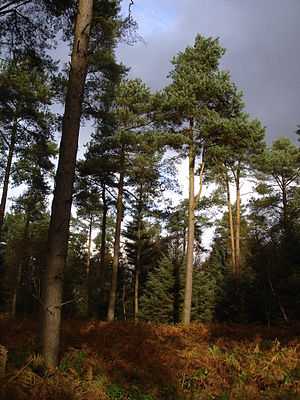Dalby Forest
Coordinates: 54°16′41″N 0°39′14″W / 54.278°N 0.654°W

Dalby Forest is a forest located on the southern slopes of the North York Moors National Park in North Yorkshire, England. It is maintained by the UK Forestry Commission. Dalby Forest, along with Langdale Forest and Cropton Forest, forms part of the North Riding Forest Park, found within the North York Moors National Park.
Botany
Dalby Forest is home to many species of wildlife such as badgers, roe deer and nightjars. There are also many species of trees including oak, beech, ash, alder and hazel.
History
There is evidence of people living in Dalby Forest since the Bronze Age. Burial mounds, linear earthworks of unknown purpose and the remains of a flourishing rabbit warrening industry have also been found throughout the woods.
During the 1930s, unemployed men were set to work in Dalby Forest, breaking ground, building tracks and undertaking other heavy labour. The men lived in a work camp at Low Dalby, which was one of a number of so-called Instructional Centres run by the Ministry of Labour in order to 'harden' young men who had been out of work for some time. By 1938, the Ministry was operating 35 Instructional Centres across Britain with a total capacity of over 6,000 places.
By 1939, unemployment was declining in the face of impending war and the Ministry closed down its work camps. However, much of Dalby village seems to be based partly on the layout of the old Instructional Centre.
Recreation
Today, Dalby Forest is used for recreation as well as timber production. There are several car parks, hiking trails and mountain bike trails, a 'forest drive' throughout the forest and a Go Ape centre. A toll is charged to enter the forest by car, although parking is free. The main visitor centre has a café and shop, which is adjacent to a selection of other businesses including a bike shop and various craft workshops.
Mountain bike trails correspond to the standard IMBA and Forestry Commission grading scheme. Some start from the main visitor centre, others from Dixons Hollow, an area a little further along the forest drive. They include:
- Two green trails, one starting from the visitor centre and one from Dixons Hollow. The green trails follow forestry roads for the duration of the trail, and as suggested by the IMBA, require a minimal amount of fitness and are suitable for families.
- A blue trail starting from the visitor centre.
- A red trail starting from Dixons Hollow. This is the longest trail and explores much of the forest. It passes nearby the visitor centre and can be accessed from it. The red trail is technical in places and requires a high level of fitness and technical proficiency. A hardtail mountain bike of a moderate spec is advised to tackle this trail.
- A black trail starting from Dixons Hollow. The black trail is highly technical with some extremely severe descents requiring a very high level of skill and fitness. Please be advised that on the newer sections of the trail there are a number of blind 3–5 ft drops which can cause serious injury if approached unaware, or at a high speed.
- A "slope-style" area at Dixons Hollow, including jumps, a corkscrew, northshore and skinnies. This has been sponsored by Pace Cycles and constructed in association with SingletrAction.[1]
The trickier trails deliberately start from Dixons Hollow, a little remote from the main visitor centre, to discourage inexperienced mountain bikers.[2]
In 2010 and 2011 the forest hosted a round of the cross-country section of the UCI Mountain Bike World Cup.
The route of The White Rose Way, a long distance walk from Leeds to Scarborough passes through the forest.
Dalby has long been a popular venue for rallying, its forest tracks, noted for their long straights and difficult bends, being used as special stages on many major national and international events.
References
- John Field, "Learning Through Labour: Training, unemployment and the state, 1890-1939", Leeds University Press, 1992, ISBN 0-900960-48-5
- "Forestry Commission UK".
External links
- Forestry Commission
- Dalby Forest at the Forestry Commission
- Lee Garland Photography shots of Dalby Forest Visitor Centre, "From Small Acorns.." September 2007
- Dalby Forest Red Mountain Bike Route Map, photos and description of Red Route.
- Dalby Forest Black Mountain Bike Route Map, photos and description of Black Route.